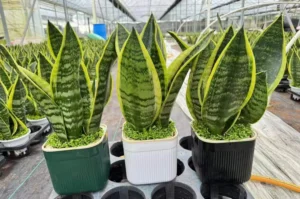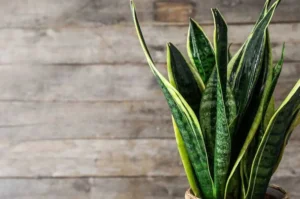Indoor gardening has taken a modern, stylish turn with homeowners leaning towards plants that are not only attractive but also low-maintenance and beneficial. Two of the top contenders in this green revolution are the Snake Plant (Sansevieria) and Aloe Vera. Both have gained immense popularity in homes and offices for their air-purifying abilities and ease of care, but which one truly deserves a spot in your home?
In this detailed comparison, we’ll break down the unique qualities of both the Snake Plant and Aloe Vera in terms of appearance, care needs, health benefits, growth patterns, toxicity, and practical use, helping you decide which plant best suits your lifestyle.
1. First Impressions: Appearance & Aesthetic Value
Snake Plant:
The Snake Plant, also called Mother-in-Law’s Tongue, boasts tall, sword-like leaves that can range from deep green to variegated yellow stripes. Its vertical form gives it a sleek, architectural look (perfect for modern or minimalist interiors).
- Height: Can grow up to 2–4 feet indoors.
- Shape: Upright, structured, dramatic.
- Varieties: Sansevieria trifasciata, Laurentii, Moonshine, Whale Fin.
Aloe Vera:
Aloe Vera has fleshy, succulent leaves that fan out from the center. Its form is more relaxed and bushy compared to the upright nature of the Snake Plant. The serrated leaf edges and semi-transparent gel give it a distinctly medicinal vibe.
- Height: Typically grows to 1–2 feet.
- Shape: Rosette, spread-out.
- Varieties: Aloe barbadensis Miller is the most common.
Winner – Tie
Choose Snake Plant for vertical elegance; pick Aloe Vera for soft, curvy textures.
2. Care and Maintenance
Snake Plant:
- Water: Infrequent (every 2–4 weeks). Overwatering can lead to root rot.
- Light: Tolerates low light but thrives in indirect bright light.
- Soil: Well-draining cactus mix or succulent soil.
- Humidity: Adaptable to various indoor conditions.
This is a hard-to-kill plant, ideal for forgetful plant parents.
Aloe Vera:
- Water: Water every 1–3 weeks; let the soil dry out completely.
- Light: Needs bright, indirect sunlight. It can burn in full sun or weaken in low light.
- Soil: Requires sandy, well-draining soil.
- Humidity: Prefers dry environments.
While Aloe Vera is also easy to care for, it’s slightly fussier about sunlight and temperature.
Winner – Snake Plant
It survives neglect and adapts better to low-light environments than Aloe Vera.
3. Health and Air-Purifying Benefits
Snake Plant:
NASA’s Clean Air Study listed Sansevieria as a top air purifier. It removes toxins such as:
- Formaldehyde
- Benzene
- Xylene
- Nitrogen oxide
Unique feature: It converts CO₂ into oxygen at night, making it ideal for bedrooms.
Aloe Vera:
Aloe Vera also purifies air, but to a lesser extent than Snake Plant. However, its true strength lies in the medicinal properties of its gel:
- Soothes sunburns and cuts
- Helps with minor skin irritations
- Has antibacterial and anti-inflammatory properties
Winner – Tie
Snake Plant is better for air quality; Aloe Vera offers skin and medicinal benefits.
4. Growth and Propagation
Snake Plant:
- Growth Rate: Slow to moderate.
- Propagation: Easy via leaf cuttings or division.
- Lifespan: Can live 5–10 years with minimal care.
Aloe Vera:
- Growth Rate: Moderate.
- Propagation: Produces offsets (“pups”) that can be easily separated.
- Lifespan: Lives up to 12 years in the right conditions.
Both plants are easy to propagate, but Aloe’s pup-based propagation is slightly more beginner-friendly.
Winner – Aloe Vera
It multiplies quickly, making it great for expanding your indoor plant collection.
5. Toxicity to Pets and Humans
Snake Plant:
- Toxicity: Mildly toxic to cats and dogs if ingested. It can cause nausea, vomiting, and diarrhea.
Aloe Vera:
- Toxicity: Gel is safe for humans (topical use), but the latex (yellowish layer just under the skin) is toxic if consumed. Also toxic to pets.
Winner – Neither
Both require placement out of reach from pets and small children.
6. Versatility and Use
Snake Plant:
- Purely ornamental.
- Popular in bedrooms, offices, and living rooms due to its upright growth and low care needs.
Aloe Vera:
- Dual purpose: Decorative + medicinal.
- Can be used for:
- Natural skincare
- DIY first aid gel
- Hair treatments
Winner – Aloe Vera
It brings more functional value to the table beyond aesthetics.
7. Indoor Climate Tolerance
Snake Plant:
- Survives in AC rooms, poor lighting, and dry air.
- Perfect for city apartments or low-light corners.
Aloe Vera:
- Prefers warmth and consistent sunlight.
- Can suffer in cold or drafty rooms.
Winner – Snake Plant
It’s a more resilient choice for varied indoor environments.
8. Cost and Availability
Both Snake Plant and Aloe Vera are widely available and budget-friendly. The price typically depends on the size and type of pot.
- Snake Plant (small pot): $10–$20
- Aloe Vera (small pot): $8–$15
Both are easily available at garden centers, plant nurseries, or online platforms like Amazon, Etsy, or The Sill.
Winner – Tie
Similar in affordability and availability.
Final Verdict: Which One Should You Choose?
| Feature | Snake Plant | Aloe Vera |
| Appearance | Sleek and structured | Soft and healing |
| Care Level | Extremely low-maintenance | Easy, but needs more light |
| Air Purification | High (NASA verified) | Moderate |
| Medicinal Use | None | Rich in healing gel |
| Pet-Safety | Mildly toxic | Mildly toxic |
| Propagation | By cuttings or division | By pups |
| Environment Adaptability | Survives anywhere indoors | Needs bright, warm spots |
Best for Beginners: Snake Plant
If you’re looking for an almost indestructible plant that purifies air and thrives in any condition, Snake Plant wins hands down.
Best for Healing and Utility: Aloe Vera
If your focus is on skincare and natural remedies, Aloe Vera is a better investment.
Expert Tip
You don’t have to choose just one.
Pair them together. Place a Snake Plant in your bedroom and an Aloe Vera in your bathroom or kitchen. Together, they make an unbeatable indoor combo of style, function, and wellness.
Conclusion
When it comes to Snake Plant vs Aloe Vera, both offer incredible value to any home. Snake Plant stands tall in style and air purification, while Aloe Vera brings the healing power of nature right to your fingertips. The right choice ultimately depends on your needs, light conditions, and aesthetic preferences.
Whether you’re a seasoned plant parent or a beginner, either of these green companions will make your space healthier and more vibrant.






